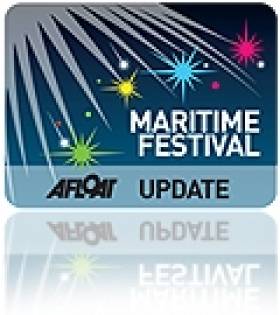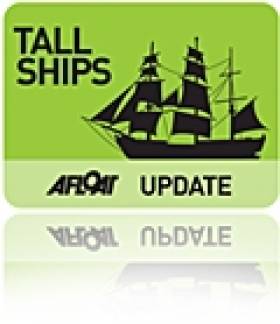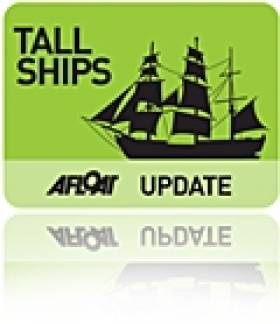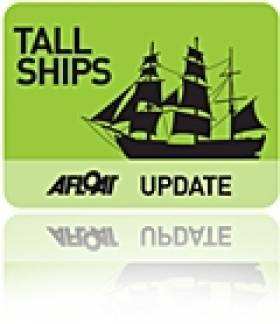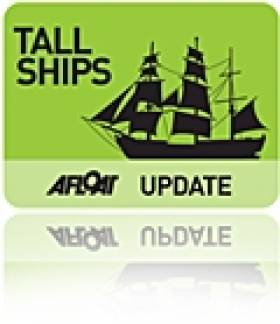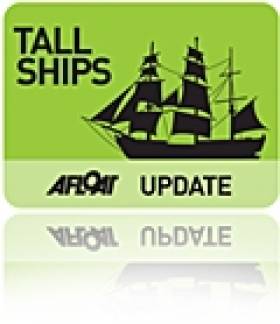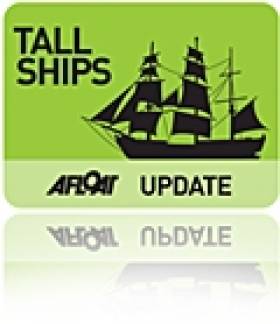Displaying items by tag: Tall Ships
Stormy Stan Sails In For Arklow's Gathering of the Fleet
#MaritimeFestivals - Stormy Stan sailed into Arklow aboard tall ship Ruth recently as part of the build up to Arklow RNLI’s Gathering of the Fleet Maritime Festival.
This August Bank Holiday weekend, Arklow RNLI and Arklow Harbour will play host to vessels of all shapes and sizes from tall ships such as Ruth to Naval Service vessels, vintage and prototype RNLI lifeboats, emergency service vessels and visiting boats from all around the UK, Ireland and further afield for the fundraising festival, which is now over 50 years old and continues to go from strength to strength.
Boat trips, kayaking and windsurfing opportunities will be up for grabs, as well as the special attraction of the Thundercat Experience, where visitors can head out on the water aboard a Thundercat racing boat.
There will be aerial attractions too, with a flying visit by the Garda Air Support Unit and the regular Air Sea Rescue Display with the Irish Coast Guard's Rescue 117 helicopter.
And that's not to mention the activities or landlubbers such as the carnival, food and craft stalls, live music, model boats, emergency service demonstrations and vintage vehicles.
Arklow RNLI volunteer lifeboat press officer Mark Corcoran said: "This weekend really is a must for maritime enthusiasts and all the family. Almost all of the events are free. This is our opportunity to put something back in our town.
"Without our communities continued support we couldn’t continue, so make sure to come down to Arklow this August Bank Holiday weekend for the Gathering of the Fleet-Arklow Maritime Festival."
He added: "There really is something for everybody, so put it in the calendar."
Full details of the festival will be available on the festival's Facebook page, where anyone with a vessel who wants to take part in the festival can make contact. There is also an opportunity for any novice or experienced sailors to arrive at the festival aboard a tall ship – e-mail [email protected] for further details.
#RiverFestival – The new Dublin Port River Festival as previously reported on Afloat.ie is approaching ever closer when it is to take place over the June Bank Holiday (1-4 June).
The event is part of an active summer season of tall ships gatherings and particularly a journey of a lifetime awaits those on board five Tall Ships which are to sail from Belfast to Dublin for the inaugural festival on the River Liffey.
To those who got bitten by The Tall Ships bug last summer when The Tall Ships Races culminated in Dublin, here's some good news. Once you are over 16, and equipped with a sense of adventure, you can sign up for the 4 day voyage on one of these Tall Ships from Belfast to Dublin.
These splendid vessels will take part in the New Dublin Port River Festival along with Currachs and 'Old Gaffers', with races happening on the river Liffey and in Dublin Bay – again all of which are to take place over the June bank holiday.
Speaking this week of her voyage from Liverpool to Drogheda on the Johanna Leucretia, Mel Gibney said 'This whole thing has been a brilliant experience, Highly recommended.'
As previously reported, last weekend Drogheda hosted The Fringe Festival and Maritime Festival which incorporated 16 local youth joining 'The Prolific' Tall Ship crew in a voyage from Liverpool to Drogheda.
Speaking as the ships sailed up the River Boyne, Minister Fergus O'Dowd TD commented 'These Sail Training Voyages can prove hugely important in personal development and in ones' personal sense of achievement - We're thrilled to hear the great stories from the 16 locals, who participated in this voyage.
Sail Training can be a truly life changing experience, so don't miss your opportunity to participate this summer. The five ships will leave Belfast on the 28 May and arrive in Dublin Port on 1 June.
There are berths still available on board the ships during this voyage for anyone that would like to experience life at sea on a traditional Tall Ship.
Age group from 16-99 years are accepted and 'No experience needed!...
If you cannot make these dates Ocean Youth Trust Scotland and The European Organisation 'Youth in Action' are also running sail training voyages in July and August around Ireland – So log on to www.sailtrainingireland.com for further information.
Drogheda Celebrates Succesful Tall Ships Festival
#tallships – Drogheda hosted its very first Maritime Festival at the weekend. The Tall ships arrived on the 3rd of May and sailed on the 6th of May with over 30,000 people having visited the port and ships over the period and the event was hailed as a tremendous success.
The ships were welcomed by His Excellency Turkish Ambassador Mr Necip Egüz as well as the Mayor of Drogheda Mr Paul Bell.
In the welcoming ceremony each of the visiting captains was presented with a copy of 'Portraits', which is a historical collection of films about 19 European seaports including Drogheda Port by the CEO of Drogheda Port Mr Paul Fleming.
Each of the Captains in return presented the Mayor of the town with a symbolic cargo, representing the main trades in Drogheda Port during the Sail Era. Captain Rob Salvidge of the Irene of Bridgewater presented a ball of Yarn, which was manufactured and exported for many years from Drogheda. Cpt Chris Rose of the Prolific presented Barley, an export which was grown in the fields locally. Captain Chris Wren of the Soteria presented Flour another popular export. Captain Topsy Toner of the Ruth presented some fine Bordeaux wine and lastly Captain Rodger Barton of the Johanna Lucretia presented a typical french import from this Era, Soap.
The Prolific had on board 16 local trainees from schools in Drogheda which had receive bursaries organised by the Port and Sail Training Ireland in conjunction with a number of local companies. The trainees had participated in a 6 day voyage from Liverpool to Drogheda.
Funding Sponsorship for Young Tall Ship Sailors
#TallShips -Funding will be made available for 20 young people from Drogheda to sail at reduced rates during the Tall Ship Sailing Voyages which is to involve six tall ships sailing from Liverpool to the Irish port.
As previously reported on Afloat.ie, the event is part of the Drogheda Fringe and Maritime Tall Ships Festival (4-6 May), when the tall ships sail from Merseyside to the Co. Louth port between 28 April-3 May.
The vessels will be open to the public open during the festival Bank Holiday Weekend. On the following day of 6 May, a 'Parade of Sail' is to see the tallships depart the Boyne.
Sail Training Ireland and Drogheda Port Company have worked together to raise sponsorship from local businesses in Drogheda to part-fund voyages for young people aged 16-30 to sail across the Irish Sea.
Bursary's of €250 are being allocated through local organisations that work with young people, community, charity and voluntary organisations.
This brings the voyage cost to €135 per person. Any organisations such as youth groups, sports-clubs, schools, charities etc that are interested in nominating their members should contact Sail Training Ireland. Bursaries will be administered on a case by case basis.
The voyages are also available in general to anyone aged 16-99. Visit www.irishsailtraining.com for information these and other voyages.
If you are interested in taking part in this voyage please contact Sail Training Ireland at: [email protected] or (01) 8876046 / 086 0346038
£27m 'Mary Rose' British Warship Museum Opens 31 May
#maryrose – The new Mary Rose Museum opens to visitors on 31 May 2013 at Portsmouth Historic Dockyard – the very same dockyard at which the warship was built over 500 years ago.
Located just metres from Nelson's flagship, HMS Victory and the ships of the modern Royal Navy, the new museum will provide one of the most significant insights into Tudor life in the world and create the new centrepiece to Portsmouth Historic Dockyard.
The Mary Rose is the only sixteenth century warship on display anywhere in the world. The ongoing £35 million heritage project to build the new museum and complete the current conservation programme on the ship and her contents has received £23m from the Heritage Lottery Fund (HLF). The HLF has been an ongoing supporter of the Mary Rose and, in addition to its £23m investment has awarded a number of other grants totalling £9.5 million over the past 18 years.
The opening marks 30 years since the hull of Mary Rose was raised from the Solent in 1982 and 437 years after she sank on 19 July, 1545: when their world stopped, our story began. The ship sank in full view of King Henry VIII while leading the attack on a French invasion fleet during the Battle of The Solent.
The new museum finally reunites the ship with the many thousands of the 19,000 artefacts raised from the wreck. The excavation and salvage of the Mary Rose created a milestone in the field of maritime archaeology and remains the largest underwater excavation and recovery ever undertaken in the world. Each object in the new museum – from human fleas to giant guns - was raised from the seabed and carefully conserved through a groundbreaking process that is still ongoing.
The new museum, led by Wilkinson Eyre Architects (architect) and Pringle Brandon (interior design) was built around the hull of the ship. The building takes the form of a finely crafted wooden 'jewellery box' with the hull at its centre and galleries running the length of the ship, each at a level corresponding to a deck level on the ship. Artefacts are displayed in such a way to provide visitors with an insight into what these decks would have looked like moments before the ship sank.
Artefacts – including the skeleton of Hatch, the ship's dog – will also be arranged in galleries by theme to help reveal some of the personal stories of life on board. Examples include:
Meet a carpenter, cook and an archer – find out more about members of crew and their associated unique objects found with them as well as their own personal belongings, see their faces revealed for the first time.
Life on board – see fine pewterware of the officers, musical instruments, books, accessories and clothing through to simple leather sandals, nit combs and even rat bones as hundreds of objects are laid out to be explored.
Realities of life: Through DNA research, precise reconstructions and through the careful use of human remains, the harsh reality of Tudor life is revealed – including the skeleton of an archer with the repetitive strain of pulling huge longbows still etched on his bones.
The historical context of the ship is set and the mystery of why she sank explored. The Mary Rose, one of the first ships able to fire a broadside, was a firm favourite of King Henry VIII. Her first battle was in 1512 and her then captain noted she was 'The noblest ship of sail'. When she sank on 19 July 1545, she had just fired a broadside and was turning. Theories range from French fire to her being overweight with cannon and troops. Her loss, and that of the estimated 500 crew (no more than 35 survived) was witnessed by the King from Portsmouth's Southsea Castle and deeply troubled the nation.
The science behind the ongoing conservation work and underwater tales of salvage are highlighted, detailing the world leading archaeology pioneered through the care of the ship and the painstaking work to discover more about Tudor life.
Portsmouth Historic Dockyard hosts over 70,000 children each year and the new Mary Rose museum contains a wide range of family focused activities including finding out how strong the men were to pull a longbow or lift a pike; the opportunity to handle replica artefacts and enjoy special demonstrations that will run frequently with costumed interpreters.
The pioneering building design has created a special environment to protect the unique and priceless 16th century artefacts and hull, and also display them in a manner that enables visitors to experience the ship in the best possible way. Conservation work on the hull is in its final phase in a 'hot box' with fabric ducts directing, in a highly sophisticated pattern, dried air at exact temperatures across all parts of the hull. Visitors will be able to see the hull through a series of windows giving different aspects over, and around, the ship. Once drying is complete in 4 to 5 years time the internal walls will be removed and the hull will be viewed through nothing but air – further enhancing the visitor experience and the connections between the hull and the artefacts.
The ongoing work with the hull and care of other artefacts requires visitor numbers and the environment to be carefully controlled. In order to achieve this tickets for the museum are time and date stamped. Visitors choose the time and date of their visit and can plan their day in Portsmouth and the Historic Dockyard visiting the Mary Rose Museum at the time on their ticket.
Visitors can explore the Mary Rose's connections across the historic city of Portsmouth. Not only was the ship built in the dockyard where she now rests, many of her 500 crew would have lived locally, the grave of the Mary Rose Sailor is at Portsmouth Cathedral and King Henry VIII watched her sink from Southsea Castle.
John Lippiett, Chief Executive of the Mary Rose Trust said: "The new Mary Rose Museum marks a new and exciting chapter in the history of The Mary Rose, providing an astonishing resource for the world to learn about the Tudors and a centre of excellence for maritime archaeology and conservation. The museum is testament to all those who have worked so hard on this remarkable [42] year project to locate, salvage and conserve the ship and her contents. We look forward to welcoming the first visitors through the door on 31 May."
Lincoln Clarke, Chief Executive of Portsmouth Historic Dockyard said: "The Mary Rose being lifted from the waters of The Solent in 1982 was a moment of national pride. Thirty years later, and through pioneering British conservation, engineering and design we have a new museum that provides the world with a treasure trove of Tudor history. The Mary Rose was built in Portsmouth 500 years ago and now, through the Museum, she confirms Portsmouth Historic Dockyard as the place to explore British naval history and further establishes the Dockyard as a major international visitor destination – with all the benefits this brings to local people and the city."
Dame Jenny Abramsky, Chair of the Heritage Lottery Fund, said: "The drama of the day the Mary Rose was raised from the depths of the Solent is forever seared in my memory – the most significant archaeological find in our nation's maritime history. Right from the start the Heritage Lottery Fund has worked closely with the Mary Rose Trust on this groundbreaking project to reunite the 500-year-old warship with thousands of artefacts telling her story. It's incredibly exciting that, after much painstaking conservation work, the Mary Rose is finally ready to go back on show in a wonderful new space where she will undoubtedly wow all who come to visit."
Historian Dan Snow, and ambassador for the new Museum said: "The story of the Mary Rose has fascinated people for generations. This tremendous new Museum housing together for the first time the hull of the ship and its many treasured artefacts will give us a sense of what life was like on aboard a Tudor ship like never before, helping to preserve the history of the Mary Rose for generations to come."
Tall Ships Coming to Dublin's New River Festival
#tallships – Sail Training Ireland have announced the visit of a number of Tall and Small-Ships to Dublin this summer. The 6 ships will sail from Belfast to Dublin, and arrive in Port in time for the Dublin Port River Festival (June Bank Holiday Weekend). This is an amazing opportunity open to anyone interested in experiencing life at sea on a traditional ship and sailing into the Capital on a tall ship voyage.
The ships are scheduled to arrive in Dublin on the 31st of May and will be in port for the June bank holiday weekend as part of the festival. You can sail into Dublin port on board one of the six majestic, traditional ships. They leave Belfast on the 28th of May and arrive in Dublin on the 31st May.
The berths cost €320 each for four days aboard.
The hope is to make this initiative an annual sail-training programme to Dublin. There will be six ships taking part: The Pelican of London, Soteria, Johanna Lucretia, Ruth, Irene and Gulden Leeuw (Images right).
The Lord Mayor of Dublin, Cnsllr Naoise Ó Muirí recently said: "One of the huge benefits of the Tall Ships is the experience offered to the trainees that take part in voyages. Through Sail Training Ireland, Dublin City Council together with Dublin Port Company funded 40 young people to sail on the ships from Spain to Dublin City during the Tall Ships Races (2012). This is a life changing experience that challenges ordinary young people to achieve their full potential and opens their horizons to great possibilities. Sail Training Ireland is making this experience available to all Irish people regardless of social, economic, physical or other circumstances. As Admiral of the Port, this is precisely the kind of activity that I support as a means of integrating the people of Dublin with its maritime heritage."
The 'Greening' of the Jeanie
#GreenTallShip- The 'greening' of our national iconic landmarks and those throughout the World are increasing in number as each St. Patrick's Day passes. Yet what about those of a floating nature, as in the case of the Dublin Docklands based Jeanie Johnston which was given a 'greening', writes Jehan Ashmore.
She is a 19th century replica emigrant ship which made her historic voyage to the United States a decade ago. For several years now the vessel has remained on this side of the giant pond, albeit in a static role, however she still has an important part to play as a tourist visitor attraction under the name of the 'Jeanie Johnston Museum Ship'.
The original 408-tonne cargoship 'Jeanie' sailed between Tralee, Co. Kerry and North America during the years 1847 to 1855. In that timeframe she carried thousand's fleeing from famine and on 3,000 mile voyages across the Atlantic in conditions braving gales and harsh seas.
How times have dramatically changed as the Irish Diaspora and visitors alike came to our shores to witness the gathering of the parade in the city-centre and the proudly lit-up tallship moored downriver along Custom House Quay.
Minister Varadkar Visits Drogheda Port
#droghedaport – The Minister for Transport, Tourism and Sport Mr Leo Varadkar visited Drogheda Port this week at the Launch of Drogheda's fringe and maritime festival. Up to six tall ships will visit the Port between the 4th and 6th May 2013.
Below the Surface Lecture: ‘The Opening of the Atlantic World’
#Lecture -The next 'Below the Surface' series of monthly held maritime lectures is 6 March. The topic will be 'The Opening of the Atlantic World' – English Settlement in Ireland and North America in the 17th Century, by James Lyttleton.
As usual the lecture takes place below decks on board the replica 19th century famine emigrant barque, Jeanie Johnston, at her berth at Custom House Quay, in Dublin's Docklands.
Doors open at 7.15pm and the lecture starts at 8pm. Please ensure to arrive early as entry to venue may not be permitted on commencement of the lecture.
For further details contact 01 4730111 and to book online, tickets costing €15.00 per person click HERE.
HMS Bounty: The Tall Ship That Should Never Have Sailed?
#TallShips - What was the HMS Bounty doing in the middle of Hurricane Sandy? It's a question that Kathryn Miles - author of a book on the history of the Jeanie Johnston - attempts to answer for Outside magazine.
As reported last October on Afloat.ie, the tall ship replica of the 18th-century square-rigged vessel - and a previous visitor to Irish shores - was sunk in the Atlantic some 100 miles off Cape Fear, forcing its crew into liferafts.
The ship's captain Robin Walbridge went missing in the incident and is presumed dead.
According to Outside, the ship has has a tumultuous history since its construction for the 1960 Hollywood film Mutiny On The Bounty starring Marlon Brando - weathering life as a seaside attraction at a Florida resort town, and as an extra in two of the Pirates of the Caribbean movies.
Since 1995 it was skippered by Walbridge, who "worked tirelessly to preserve the vessel" and took her as far and wide as the Great Lakes, the Panama Canal and Europe - including visits to Cork Harbour in 2009 and Belfast Lough in 2011, reflecting the original vessel's Irish connections (Captain William Bligh designed the North Bull Wall and surveyed Dublin Bay some years after the infamous mutiny).
But preservation requires funding, and it's that struggle for funding that may have encouraged the captain to push the limits of his vessel and its crew.
Outside has much more on the story HERE.




























